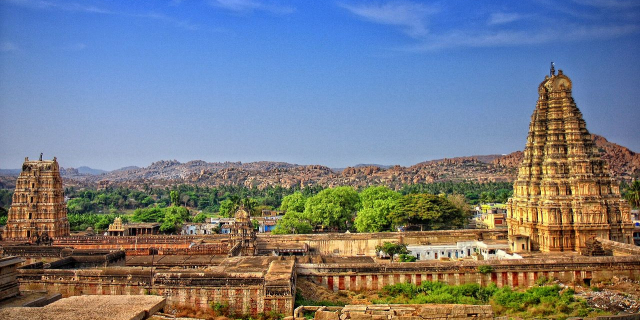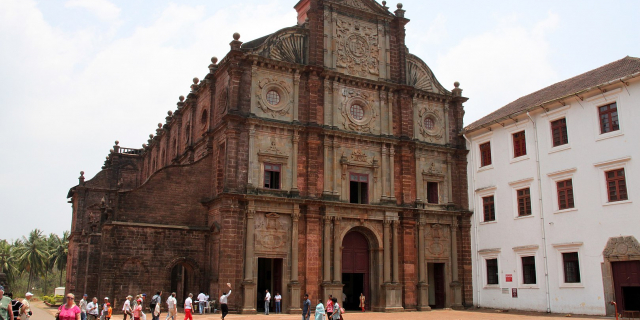Pattadakal, also called Raktapura, is a complex of 7th and 8th century CE Hindu and Jain temples in northern Karnataka, India. Located on the west bank of the Malaprabha River in Bagalkot district, this UNESCO World Heritage Site is 23 kilometres (14 mi) from Badami and about 9.7 kilometres (6 mi) from Aihole, both of which are historically significant centres of Chalukya monuments. The monument is a protected site under Indian law and is managed by the Archaeological Survey of India (ASI).
UNESCO has described Pattadakal as "a harmonious blend of architectural forms from northern and southern India" and an illustration of "eclectic art" at its height. The Hindu temples are generally dedicated to Shiva, but elements of Vaishnavism and Shaktism theology and legends are also featured. The friezes in the Hindu temples display various Vedic and Puranic concepts, depict stories from the Ramayana, the Mahabharata, the Bha...Read more
Pattadakal, also called Raktapura, is a complex of 7th and 8th century CE Hindu and Jain temples in northern Karnataka, India. Located on the west bank of the Malaprabha River in Bagalkot district, this UNESCO World Heritage Site is 23 kilometres (14 mi) from Badami and about 9.7 kilometres (6 mi) from Aihole, both of which are historically significant centres of Chalukya monuments. The monument is a protected site under Indian law and is managed by the Archaeological Survey of India (ASI).
UNESCO has described Pattadakal as "a harmonious blend of architectural forms from northern and southern India" and an illustration of "eclectic art" at its height. The Hindu temples are generally dedicated to Shiva, but elements of Vaishnavism and Shaktism theology and legends are also featured. The friezes in the Hindu temples display various Vedic and Puranic concepts, depict stories from the Ramayana, the Mahabharata, the Bhagavata Purana, as well as elements of other Hindu texts, such as the Panchatantra and the Kirātārjunīya. The Jain temple is only dedicated to a single Jina. The most sophisticated temples, with complex friezes and a fusion of Northern and Southern styles, are found in the Papanatha and Virupaksha temples. The Virupaksha temple is an active house of Hindu worship.
The Mallaprabha River, a tributary of the Krishna River cutting across the valley of mountains surrounded and the plains has great importance and place in this history of south India. The origin of this river is from Kanakumbi, Belagavi district, in the western ghats region flows towards the eastern side. Just one kilometre (0.62 mi) before reaching Pattadakal it starts flowing from south to north. As per the Hindu tradition, a river that flows in the north direction is also called Uttarvahini Ganga.
Pattadakal ("Stone of coronation") was considered a holy place, being where the Malaprabha river turned northwards towards the Himalayas and the Kailasha mountain (uttara-vahini). As its name implies, it was used during the Chalukya dynasty for coronation ceremonies, such as that of Vinayaditya in the 7th century CE.[1][2] Other names this place was known by were Kisuvolal meaning "valley of red soil", Raktapura meaning "city of red", and Pattada-Kisuvolal meaning "red soil valley for coronation".[1][3][4] The site, states Archaeological Survey of India, is mentioned in texts by Srivijaya and is referred to by Ptolemy as "Petirgal" in his Geography.[1]
The early rulers of the Chalukya during the 5th – 6th century were Vaishnavites (a community that believes and offers prayers to Lord Vishnu, followers of Vaishnavism) and then converted themselves into Shivaites (a community that believes and offer prayers to Lord Shiva and followers of Shivaism). Hence the temples in and around this compound are dedicated to Lord Shiva.
Pattadakal became, along with nearby Aihole and Badami, a major cultural centre and religious site for innovations in architecture and experimentation of ideas.[1] The rule of the Gupta Empire during the 5th century brought about a period of political stability, during which Aihole became a locus of scholarship. The experimentations in architecture extended into Badami over the course of the next two centuries. This culture of learning encompassed Pattadakal in the 7th century which became a nexus where ideas from northern and southern India fused.[1][5] It was during this latter period that the Chalukya empire constructed many of the temples in Aihole-Badami-Pattadakal region.[6][7]
After the fall of the Chalukya Empire, the region was annexed by the Rashtrakuta kingdom, who would rule over the region into the 10th century. In the 11th century, and into the 12th century, the region came under the rule of the Late Chalukyas (Western Chalukya Empire, Chalukyas of Kalyani), an offshoot of the Early Chalukya Empire.[8][9] Although the area was not a capital region, nor in proximity to one, numerous sources such as inscriptions, contemporaneous texts and the architectural style indicate that, from the 9th to 12th centuries, new Hindu, Jain and Buddhist temples and monasteries continued to be built in the Pattadakal region. Historian George Michell attributes this to the presence of a substantial population and its burgeoning wealth.[8]
In the advent of the 14th century, Pattadakal, the Malaprabha valley, as well as much of the Deccan region, was subject to raids and plunder by the Delhi Sultanate armies that devastated the region.[8][10] This period ended with the rise of the Vijayanagara Empire. It was responsible for the construction of forts for the protection of the monuments, as evidenced by inscriptions in the fort at Badami. Pattadakal was a part of the border region that witnessed wars between Vijayanagara and the Sultanates to its north. Following the collapse of Vijayanagara Empire in 1565, Pattadakal was annexed by the Sultanate of Bijapur, which was ruled by the Adil Shahi dynasty.[8] In the late 17th century, the Mughal Empire, under Aurangzeb, gained control of Pattadakal from the Sultanate. After the collapse of the Mughal Empire, Pattadakal came under the control of the Maratha Empire. It later changed hands, yet again, when Haider Ali and Tipu Sultan wrested control of it in late 18th century but would lose it when the British defeated Tipu Sultan and annexed the region.[8]
The monuments at Pattadakal are evidence of the existence, and the history, of interaction between the early northern and southern styles of Hindu arts.[11] According to T. Richard Blurton, the history of temple arts in northern India is unclear as the region was repeatedly sacked by invaders from Central Asia, particularly during the Muslim incursions from the 11th century onward. The subsequent "warfare has greatly reduced the quantity of surviving examples". The Pattadakal monuments completed in 7th and 8th century are among the earliest surviving examples of these early religious arts and ideas.[11][12]
Prehistoric Monuments
Based on some recent findings by Archeologist and pre-historian Prof. Ravi Korisettar published works for National Institutes of Advance studies, India, the Early Chalukyan artisans were not the first to build monuments in the Malaprabha Valley. At Bachinnagudda, just a couple of kilometres west of Pattadakallu, along the road leading to Badami, is a rough-looking monument believed to date back to the Iron Age (approximately 1200 BCE – 500 BCE). This monument, called a dolmen, belongs to a class of structures called megaliths, which were erected all over southern India mostly during the Iron Age and the succeeding Early Historic period.[13][14]































Add new comment